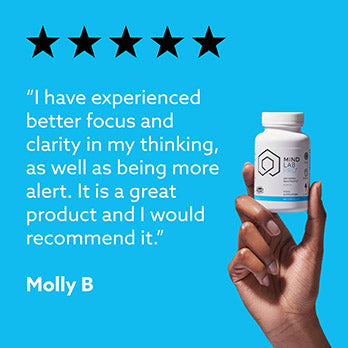You're standing at the front of a crowded room, prepared to give a speech in front of your peers. Your knees are shaky, palms clammy, and your heart is racing. You can't think straight, and you've forgotten everything you wanted to say.
Fear can cripple us in our everyday lives. It can mess with your confidence, keep you from accomplishing things you want to do, and even take a toll on mental health. But recent research suggests cognitive enhancers like nootropics for fear may help us overcome our fears.
- Cognitive enhancers that target neurotransmitter systems - including serotonin, dopamine, and GABA - seem to work better than anxiolytics for long-term fear intervention.<1>
In this guide we'll discuss what fear really is and how it works in the brain and body – including ways you can use brain-boosting nootropics for fear to focus and perform better under pressure.
What is Fear?

In a cognitive sense, fear is a behavioral control that keeps us from doing dangerous things like crawling into the lion cage at the zoo or running a red light.
During humanity's early evolutionary stages, a healthy sense of fear helped us survive as a species by spurring the fight-or-flight response to life-threatening dangers like being chased by wild animals.
"Fear is a conscious awareness that you are in danger."
~ neuroscientist Joseph LeDoux
But in the 21st century, most of our fears are a product of misperception.
The Fear Center
You may have heard the amygdala is the "fear center" of the brain. This idea is often attributed to neuroscientist and amygdala expert Joseph E. LeDoux, but it is actually based on an incorrect interpretation of old studies.
- Some early studies showed that monkeys with amygdala damage have a diminished fight-or-flight response to normal fear-inducing stimuli like snakes.<2>
But it turns out the amygdala isn't the only brain area responsible for fight-or-flight impulses. LeDoux stresses that while humans (and monkeys) are indeed less responsive to threats when the amygdala is damaged, they can still experience fear.
Fear in the Brain
According to recent research, there is no fear center in our brain. Instead, we seem to have a two-system framework that connects defense circuits with regulatory circuits. This dual system stimulates generates both conscious feelings and behavioral and physiological response to perceived threats.<3>
Sub-Cortical Fear Center View
The traditional view assumes fear arises from sub-cortical regions, particularly the amygdala, that control behavioral and physiological response. But subjective experiences of fear and panic contradict this theory. If this were the case, everyone would have the same behavioral and physiological response to fear.
And while people with amygdala damage do show diminished fear response to certain stimuli, they can still feel fear and panic.<4>
The amygdala does play a big part in processing fear. Even subliminal threats can activate it.
But it also controls neurotransmitter release of hormones that cause feelings of pleasure, including serotonin, dopamine, and GABA.
And something as powerful as fear is more than a one-trick pony.
Cortical Circuits and Consciousness
The two-system fear model recognizes the individuality of behavioral and physiological response to stimuli and supports the role of cortices involved in higher-order cognitive functions like working memory and attention. These include the lateral and medial prefrontal cortices and the parietal neocortex.<5>
- The insula, in the frontal cortex, is responsible for somatic sensory awareness and may be a major player in fear related to physiological stimuli - like the feeling that bugs are crawling on you or a hand suddenly clasping your shoulder.
Fear and Cognition
What we feel as fear is cognitively constructed in our brains from a combination of non-conscious ingredients based on a stimulus and memories of past experiences with similar stimuli.
Many of our fears are learned in childhood. We can learn them from someone else or form them based on our own early experience.
The perceived threat itself doesn't cause fear. The debilitating feeling of fear happens when the defense system is activated by a perceptual representation of the threat in memory.
This representation goes to the amygdala which activates arousal systems in the brain and adrenals in the gut (your "second brain") that increase alertness and direct attention to the stimulant.
- To sum it up – the sensory stimulus, the memory of that stimulus in the past, and the defense system's arousal all come together in the working memory and exhibit as fear.
How Does Fear Work?
The brain's defense system helps us get out of danger quickly without analyzing too much information.
In emergency situations the brain can’t waste time processing all the available information so it takes a snapshot of the situation, analyzes just that information and divides all of it into just two categories: threat or non-threat.
-
Not all fear systems are created equal.
Some of us have defense systems that are more sensitive or active than others. The more you use a network the stronger it gets, and fears grow stronger the more they are triggered. When we spend a lot of time around people are overly stressed, depressed, anxious, or angry, our neural networks may begin to mimic those mind states.
Take control of the fear system that might be in overdrive. You have the power to override this system. Most people don’t even know it exists or how to use it. Nootropics for fear could help mediate the defense system's fear signaling.
Tips for overcoming fear
We will never completely eliminate fear, and we shouldn’t. Without a little healthy fear we may have significantly shorter life spans or permanently injure ourselves a great deal more often.
But you can weaken your fears to improve both life experience and cognitive function.
- Face your fear. Each time you refuse to let it run you, the fear gets a little bit smaller. Your brain realizes you’re not going to die, and every time you face that fear it recedes off a little bit more. You can’t permanently get rid of it, but you can keep it as low as possible by confronting your fear each and every time.
- The three second rule. When a fear comes up, let yourself feel it for three seconds, then do something about it. This bypasses your brain’s defense system and triggers the action system instead. When you perform a physical action the brain thinks the body is getting away from danger.
- Anchor thought. This therapeutic technique uses an emotionally powerful positive thought pull you out of your fear and into the moment. Think about a specific place where you feel really happy and centered. Count back from five to one. Envision your happy place and say, “I’m so excited about ____!" This interrupts the fear cycle and awakens the pre-frontal cortex, allowing you to regain rational cognitive control. Your mind will then interpret the physical symptoms of fear (like a racing heart) as excitement instead of fear.
- Enhance cognitive power. Stronger cognition can help maintain cortical control when the amygdala starts sending fear messages. Maintaining conscious awareness of what are true threats and what are not can lessen the emotional fear response.
Mind Lab Pro® Nootropics for Fear
Fear isn't a product of just one brain area, but rather a result of systemic action including neurotransmitters, higher cognitive functions, and basic alert mechanisms. Fear is a multifaceted phenomenon and requires a multifaceted approach.
Mind Lab Pro® contains some of the best nootropics for fear, including:
Bacopa Monnieri
The amygdala is a major player in processing fear, and serotonin is one of its primary modulators.
- Research suggests Bacopa can increase Serotonin Transporter (SERT) expression - which can reduce fear response in the amygdala.<6>
The amygdala also contains dopamine D2 receptors that help facilitate fear extinction when activated. Dopamine inputs to the prefrontal cortex also help regulate working memory and attention, two cognitive functions intimately involved in modulating the fear response.<7>
The bacosides in Bacopa monnieri are directly involved with regulation of both serotonin and dopamine. Plus they increase GABA receptors related to stress and fear regulation.
More on Mind Lab Pro® Bacopa Monnieri
Rhodiola Rosea
Rhodiola is an adaptogenic herb that can suppress the steroid hormone cortisol. Adrenal glands flood the defense system with cortisol to instigate the fight-or-flight response. And cortisol can build up in the blood over time, making you more susceptible to fear, stress, and cognitive impairment.
- Rhodiola works to soothe the fear response by interacting with cortisol-reducing HPA system, nitric oxide, and defense mechanism proteins.<8>
More on Mind Lab Pro® Rhodiola Rosea
L-Theanine
L-theanine is an amino acid found in green tea that induces mellow alpha brain waves, calming busy gamma and beta brain waves associated with fear states. It also encourages dopamine production for better fear resistance and regulates other neurotransmitters involved in the fight-or-flight response like serotonin and GABA.
- Though it is one of the most researched nootropics for fear, L-theanine works to calm the body and mind in so many ways researchers state,
"Overall, L-theanine displays a neuropharmacology suggestive of a possible neuroprotective and cognitive enhancing agent and warrants further investigation in animals and humans."<9>
More on Mind Lab Pro® L-Theanine
Conclusion
Mind Lab Pro® nootropics for fear supports a balanced mind state for effective stress management.
Mind Lab Pro® can enhance mental performance so you can stay focused and perform better in tough situations. And you just might find yourself going further faster than ever before.
- Mind Lab Pro®’s whole-brain Universal Nootropic™ calms unruly steroid hormones and boosts cognitive functions directly involved with fear.
Our brains are wired to avoid pain at all costs, but that can actually stop us from having the life we dream of. Whatever fear you're facing, Mind Lab Pro® nootropics for fear can help you deactivate an overeager defense system and focus on what you really want – not the fear.
References
- Butler AC, Roediger HL. Testing improves long-term retention in a simulated classroom setting. Journal European Journal of Cognitive Psychology. Volume 19, 2007 - Issue 4-5: Bridging Cognitive Science and Education: Learning, Memory, and Metacognition. doi: 10.1080/09541440701326097.
- Hartwig MK, Dunlosky J. Study strategies of college students: Are self-testing and scheduling related to achievement? Psychon Bull Rev (2012) 19: 126. doi: 10.3758/s13423-011-0181-y
- Smith EE, Jonides J. Storage and executive processes in the frontal lobes. Science. 1999 Mar 12;283(5408):1657-61.
- Arnsten A, Mazure CM, Sinha R. Neural circuits responsible for conscious self-control are highly vulnerable to even mild stress. When they shut down, primal impulses go unchecked and mental paralysis sets in. Scientific American. 2012 Apr; 306(4): 48–53. PMCID: PMC4774859.
- McDaniel MA, Thomas RC, Agarwal PK, McDermott KB, Roediger HL. Quizzing in middle-school science: successful transfer performance on classroom exams. Appl Cognit Psychol. 2013;27:360–372.
- Stranger-Hall KF. Multiple-choice exams: an obstacle for higher-level thinking in introductory science classes. CBE Life Sci Educ. 2012 Fall;11(3):294-306. doi: 10.1187/cbe.11-11-0100.
- Goetz T, et al. Emotional experiences during test taking: Does cognitive ability make a difference? Learning and Individual Differences. 2007. 17, pp. 3-16.
- Roodenrys S, et al. Chronic effects of Brahmi (Bacopa Monnieri) on human memory. Neuropsychopharmacology. 2002 Aug;27(2):279-81.
- Olsson EM, von Schéele B, Panossian AG. A randomised, double-blind, placebo-controlled, parallel-group study of the standardised extract shr-5 of the roots of Rhodiola rosea in the treatment of subjects with stress-related fatigue. Planta Med. 2009 Feb;75(2):105-12. doi: 10.1055/s-0028-1088346.
- Owen GN, Parnell H, De Bruin EA, Rycroft JA. The combined effects of L-theanine and caffeine on cognitive performance and mood. Nutr Neurosci. 2008 Aug;11(4):193-8. doi: 10.1179/147683008X301513.



































